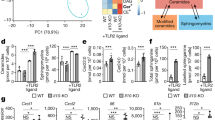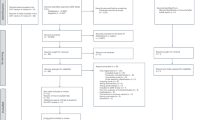Abstract
Activation of the 5-lipoxygenase (5-LO) pathway leads to the biosynthesis of proinflammatory leukotriene lipid mediators. Genetic studies have associated 5-LO and its accessory protein, 5-LO-activating protein, with cardiovascular disease, myocardial infarction and stroke. Here we show that 5-LO-positive macrophages localize to the adventitia of diseased mouse and human arteries in areas of neoangiogenesis and that these cells constitute a main component of aortic aneurysms induced by an atherogenic diet containing cholate in mice deficient in apolipoprotein E. 5-LO deficiency markedly attenuates the formation of these aneurysms and is associated with reduced matrix metalloproteinase-2 activity and diminished plasma macrophage inflammatory protein-1α (MIP-1α; also called CCL3), but only minimally affects the formation of lipid-rich lesions. The leukotriene LTD4 strongly stimulates expression of MIP-1α in macrophages and MIP-2 (also called CXCL2) in endothelial cells. These data link the 5-LO pathway to hyperlipidemia-dependent inflammation of the arterial wall and to pathogenesis of aortic aneurysms through a potential chemokine intermediary route.
This is a preview of subscription content, access via your institution
Access options
Subscribe to this journal
Receive 12 print issues and online access
$209.00 per year
only $17.42 per issue
Buy this article
- Purchase on Springer Link
- Instant access to full article PDF
Prices may be subject to local taxes which are calculated during checkout






Similar content being viewed by others
References
Ross, R. Atherosclerosis—an inflammatory disease. N. Engl. J. Med. 340, 115–126 (1999).
Steinberg, D. Atherogenesis in perspective: hypercholesterolemia and inflammation as partners in crime. Nat. Med. 8, 1211–1217 (2002).
Libby, P. Inflammation in atherosclerosis. Nature 420, 868–874 (2002).
Libby, P., Ridker, P.M. & Maseri, A. Inflammation and atherosclerosis. Circulation 105, 1135–1143 (2002).
Samuelsson, B. Leukotrienes: mediators of immediate hypersensitivity actions and inflammation. Science 220, 568–575 (1983).
Funk, C.D. Prostaglandins and leukotrienes: advances in eicosanoid biology. Science 294, 1871–1875 (2001).
De Caterina, R. et al. Leukotriene B4 production in human atherosclerotic plaques. Biomed. Biochim. Acta 47, S182–S185 (1988).
Patrignani, P. et al. Release of contracting autacoids by aortae of normal and atherosclerotic rabbits. J. Cardiovasc. Pharmacol. 20, S208–S210 (1992).
Spanbroek, R. et al. Expanding expression of the 5-lipoxygenase pathway within the arterial wall during human atherogenesis. Proc. Natl. Acad. Sci. USA 100, 1238–1243 (2003).
Mehrabian, M. et al. Identification of 5-lipoxygenase as a major gene contributing to atherosclerosis susceptibility in mice. Circ. Res. 91, 120–126 (2002).
Dwyer, J.H. et al. Arachidonate 5-lipoxygenase promoter genotype, dietary arachidonic acid, and atherosclerosis. N. Engl. J. Med. 350, 29–37 (2004).
Helgadottir, A. et al. The gene encoding 5-lipoxygenase activating protein confers risk of myocardial infarction and stroke. Nat. Genet. 36, 233–239 (2004).
Aiello, R.J. et al. Leukotriene B4 receptor antagonism reduces monocytic foam cells in mice. Arterioscler. Thromb. Vasc. Biol. 22, 443–449 (2002).
Subbarao, K. et al. Role of leukotriene B4 receptors in the development of atherosclerosis: potential mechanisms. Arterioscler. Thromb. Vasc. Biol. 24, 369–375 (2004).
Chen, X.S. et al. cDNA cloning, expression, mutagenesis, intracellular localization and gene chromosomal assignment of mouse 5-lipoxygenase. J. Biol. Chem. 270, 17993–17999 (1995).
Mehrabian, M. et al. Genetic locus in mice that blocks development of atherosclerosis despite extreme hyperlipidemia. Circ. Res. 89, 125–130 (2001).
Hart, D.N. Dendritic cells: Unique leukocyte populations which control the primary immune response. Blood 90, 3245–3287 (1997).
Silence, J., Lupu, F., Collen, D. & Lijnen, H.R. Persistence of atherosclerotic plaque but reduced aneurysm formation in mice with stromelysin-1 (MMP-3) gene inactivation. Arterioscler. Thromb. Vasc. Biol. 21, 1440–1445 (2001).
Daugherty, A., Manning, M.W. & Cassis, L.A. Antagonism of AT2 receptors augments angiotensin II–induced abdominal aortic aneurysms and atherosclerosis. Br. J. Pharmacol. 134, 865–870 (2001).
Bruemmer, D. et al. Angiotensin II–accelerated atherosclerosis and aneurysm formation is attenuated in osteopontin-deficient mice. J. Clin. Invest. 112, 1318–1331 (2003).
Longo, G.M. et al. Matrix metalloproteinases 2 and 9 work in concert to produce aortic aneurysms. J. Clin. Invest. 110, 625–632 (2002).
Lötzer, K. et al. Differential leukotriene receptor expression and calcium responses in endothelial cells and macrophages indicate 5-lipoxygenase-dependent circuits of inflammation and atherogenesis. Arterioscler. Thromb. Vasc. Biol. 23, e32–e36 (2003).
Daugherty, A. & Cassis, L.A. Mouse models of abdominal aortic aneurysms. Arterioscler. Thromb. Vasc. Biol. 24, 429–434 (2004).
Manning, M.W., Cassis, L.A., Huang. J., Szilvassy, S.J. & Daugherty, A. Abdominal aortic aneurysms: fresh insights from a novel animal model of the disease. Vasc. Med. 7, 45–54 (2002).
Sinha, S. & Frishman, W.H. Matrix metalloproteinases and abdominal aortic aneurysms: a potential therapeutic target. J. Clin. Pharmacol. 38, 1077–1088 (1998).
Werb, Z. ECM and cell surface proteolysis: regulating cellular ecology. Cell 91, 439–442 (1997).
Zhou, X., Paulsson, G., Stemme, S. & Hansson, G.K. Hypercholesterolemia is associated with a T helper (Th) 1/Th2 switch of the autoimmune response in atherosclerotic apoE-knockout mice. J. Clin. Invest. 101, 1717–1725 (1998).
Houtkamp, M.A., de Boer, O.J., van der Loos, C.M., van der Wal, A.C. & Becker, A.E. Adventitial infiltrates associated with advanced atherosclerotic plaques: structural organization suggests generation of local humoral immune responses. J. Pathol. 193, 263–269 (2001).
Kumamoto, M., Nakashima, Y. & Sueishi, K. Intimal neovascularization in human coronary atherosclerosis: its origin and pathophysiological significance. Hum. Pathol. 26, 450–456 (1995).
Dollery, C.M. et al. Neutrophil elastase in human atherosclerotic plaques: production by macrophages. Circulation 107, 2829–2836 (2003).
Hansson, G.K., Libby, P., Schonbeck, U. & Yan, Z.Q. Innate and adaptive immunity in the pathogenesis of atherosclerosis. Circ. Res. 91, 281–291 (2002).
Lusis, A.J. Atherosclerosis. Nature 407, 233–241 (2000).
Kuhel, D.G., Zhu, B., Witte, D.P. & Hui, D.Y. Distinction in genetic determinants for injury-induced neointimal hyperplasia and diet-induced atherosclerosis in inbred mice. Arterioscler. Thromb. Vasc. Biol. 22, 955–960 (2002).
Shi, W. et al. Genetic backgrounds but not sizes of atherosclerotic lesions determine medial destruction in the aortic root of apolipoprotein E–deficient mice. Arterioscler. Thromb. Vasc. Biol. 23, 1901–1906 (2003).
Galis, Z.S. & Khatri, J.J. Matrix metalloproteinases in vascular remodeling and atherogenesis: the good, the bad, and the ugly. Circ. Res. 90, 251–262 (2002).
Ward, M.R., Pasterkamp, G., Yeung, A.C. & Borst, C. Arterial remodeling. Mechanisms and clinical implications. Circulation 102, 1186–1191 (2000).
Baggiolini, M. Chemokines and leukocyte traffic. Nature 392, 565–568 (1998).
Springer, T.A. Traffic signals for lymphocyte recirculation and leukocyte emigration: the multistep paradigm. Cell 76, 301–314 (1994).
Mach, F. et al. Differential expression of three T lymphocyte–activating CXC chemokines by human atheroma-associated cells. J. Clin. Invest. 104, 1041–1050 (1999).
Apostolopoulos, J., Davenport, P. & Tipping, P.G. Interleukin-8 production by macrophages from atheromatous plaques. Arterioscler. Thromb. Vasc. Biol. 16, 1007–1012 (1996).
Koch, A.E. et al. Enhanced production of the chemotactic cytokines interleukin-8 and monocyte chemoattractant protein-1 in human abdominal aneurysms. Am. J. Pathol. 142, 1423–1431 (1993).
Gerszten, R.E. et al. MCP-1 and IL-8 trigger firm adhesion of monocytes to vascular endothelium under flow conditions. Nature 22, 718–723 (1999).
Pelus, L.M., Bian, H., King, A.G. & Fukuda, S. Neutrophil-derived MMP-9 mediates synergistic mobilization of hematopoietic stem and progenitor cells by the combination of G-CSF and the chemokines GROβ/CXCL2 and GROβT/CXCL2δ4. Blood 103, 110–119 (2004).
Boisvert, W.A., Santiago, R., Curtiss, L.K. & Terkeltaub, R.A. A leukocyte homologue of the IL-8 receptor CXCR-2 mediates the accumulation of macrophages in atherosclerotic lesions of LDL receptor-deficient mice. J. Clin. Invest. 101, 353–363 (1998).
Luster, A.D. Chemokines—chemotactic cytokines that mediate inflammation. N. Engl. J. Med. 338, 436–445 (1998).
Chen, X.S., Sheller, J.R., Johnson, E.N. & Funk, C.D. Role of leukotrienes revealed by targeted disruption of the 5-lipoxygenase gene. Nature 372, 179–182 (1994).
Goulet, J.L., Snouwaert, J.N., Latour, A.M., Coffman, T.M. & Koller, B.H. Altered inflammatory responses in leukotriene-deficient mice. Proc. Natl. Acad. Sci. USA 91, 12852–12856 (1994).
Tangirala, R.K., Rubin, E.M. & Palinski, W. Quantitation of atherosclerosis in murine models: correlation between lesions in the aortic origin and in the entire aorta, and differences in the extent of lesions between sexes in LDL receptor–deficient and apolipoprotein E–deficient mice. J. Lipid Res. 36, 2320–2328 (1995).
Cyrus, T. et al. Effect of low-dose aspirin on vascular inflammation, plaque stability, and atherogenesis in low-density lipoprotein receptor-deficient mice. Circulation 106, 1282–1287 (2002).
Basso, K. et al. Gene expression profiling of hairy cell leukemia reveals a phenotype related to memory B cells with altered expression of chemokine and adhesion receptors. J. Exp. Med. 199, 59–68 (2004).
Acknowledgements
We thank J.A. Lawson for technical support with LC–MS/MS assays; A.J. Cucchiara for assistance with statistical analysis; M. Hildner and G. Weber for technical assistance with microarray analyses, real-time RT-PCR and immunohistochemical morphometry; D. Marchadier and S. Jahn for lipoprotein profile analyses; J. Ventre, T. Dobber and J. Menke for insulin measurements; and B. Koller for 5-LO−/− mice. This work was supported by grants from the National Institutes of Health (HL53558 to C.D.F.; HL70128 and HL55323 to D.J.R.), the Canadian Institutes of Health Research (MOP-67146 to C.D.F.), the Deutsche Forschungsgemeinschaft (Ha 1083/13-1/13-2/13-3/13-4/12-5/12-6), the European Union research network (QLG1-CT-2001-01521 to A.J.R.H.), the Interdisziplinäre Zentrum für Klinische Forschung Jena and the Singulair Medical School Program (to A.J.R.H.), and by an American Heart Association postdoctoral fellowship (0225369U to L.Z.). C.D.F. holds a Canada Research Chair in Molecular, Cellular and Physiological Medicine.
Author information
Authors and Affiliations
Corresponding author
Ethics declarations
Competing interests
The authors declare no competing financial interests.
Supplementary information
Supplementary Fig. 1
5-LO expression in bone marrow cells and peritoneal macrophages. (PDF 127 kb)
Supplementary Fig. 2
Genotype analysis of mice. (PDF 108 kb)
Supplementary Table 1
LC/MS/MS quantitation of leukotrienes extracted from aortas of Apoe−/− and Apoe−/− Alox5−/− mice. (PDF 24 kb)
Supplementary Table 2
2a. Effect of 5-LO deficiency on aortic lipid deposition in mouse models of atherosclerosis. (PDF 27 kb)
2b. Lesion quantitation at the aortic root in mouse models of atherosclerosis.
2c. Effect of 5-LO deficiency on plaque size and Intima/Media ratio in apoE-/- mice.
Supplementary Table 3
Plasma total cholesterol levels in mouse models of atherosclerosis. (PDF 22 kb)
Supplementary Table 4
Plasma insulin levels in mouse models of atherosclerosis. (PDF 23 kb)
Supplementary Table 5
Effect of 5-LO deficiency on plasma cytokine and chemokine levels in mouse models of atherosclerosis. (PDF 24 kb)
Rights and permissions
About this article
Cite this article
Zhao, L., Moos, M., Gräbner, R. et al. The 5-lipoxygenase pathway promotes pathogenesis of hyperlipidemia-dependent aortic aneurysm. Nat Med 10, 966–973 (2004). https://doi.org/10.1038/nm1099
Received:
Accepted:
Published:
Issue Date:
DOI: https://doi.org/10.1038/nm1099
This article is cited by
-
Integrative analyses of TEDDY Omics data reveal lipid metabolism abnormalities, increased intracellular ROS and heightened inflammation prior to autoimmunity for type 1 diabetes
Genome Biology (2021)
-
Metabolism pathways of arachidonic acids: mechanisms and potential therapeutic targets
Signal Transduction and Targeted Therapy (2021)
-
Delayed extensive brain edema caused by the growth of a giant basilar apex aneurysm treated with basilar artery obliteration: a case report
BMC Neurology (2020)
-
Inflammation promotes progression of thrombi in intracranial thrombotic aneurysms
Neurosurgical Review (2020)
-
Modulation of reactive oxygen levels and gene expression in sensitive and resistant tumoral cells by C-phyocyanin
Molecular Biology Reports (2019)



